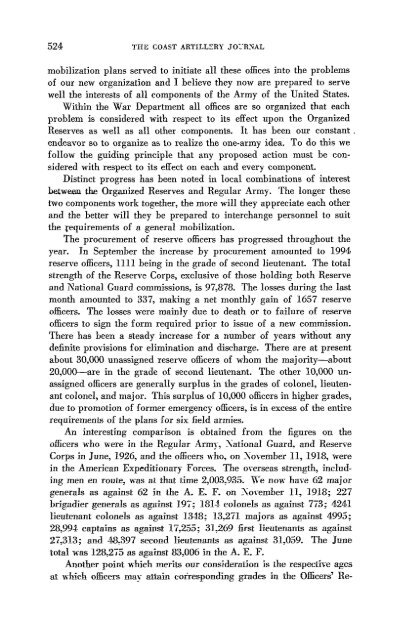COAST ARTILLERY, JOURNAL - Air Defense Artillery
COAST ARTILLERY, JOURNAL - Air Defense Artillery
COAST ARTILLERY, JOURNAL - Air Defense Artillery
Create successful ePaper yourself
Turn your PDF publications into a flip-book with our unique Google optimized e-Paper software.
524 THE <strong>COAST</strong> ARTILL:::RY JO:.R~AL<br />
mobilization plans served to initiate all these officesinto the problems<br />
of our new organization and I believe they now are prepared to serve<br />
well the interests of all components of the Army of the United States.<br />
Within the War Department all offices are so organized that each<br />
problem is considered with respect to its effect upon the Organized<br />
Reserves as well as all other components. It has been our constant .<br />
endeavor so to organize as to realize the one-army idea. To do this we<br />
follow the guiding principle that any proposed action must be considered<br />
with respect to its effect on each and every component.<br />
Distinct progress has been noted in local combinations of interest<br />
between the Organized Reserves and Regular Army. The longer these<br />
two components work together, the more will they appreciate each other<br />
and the better will they be prepared to interchange personnel to suit<br />
the requirements of a general mobilization.<br />
The procurement of reserve officers has progressed throughout the<br />
year. In September the increase by procurement amounted to 1994<br />
reserve officers,llll being in the grade of second lieutenant. The total<br />
strength of the Reserve Corps, exclusive of those holding both Reserve<br />
and National Guard commissions, is 97,878. The losses during the last<br />
month amounted to 337, making a net monthly gain of 1657 reserve<br />
officers. The losses were mainly due to death or to failure of reserve<br />
officers to sign the form required prior to issue of a new commission.<br />
There has been a steady increase for a number of years without any<br />
definite provisions for elimination and discharge. There are at present<br />
about 30,000 unassigned reserve officers of whom the majority-about<br />
20,OOG--arein the grade of second lieutenant. The other 10,000 unassigned<br />
officersare generally surplus in the grades of colonel, lieutenant<br />
colonel, and major. This surplus of 10,000 officersin higher grades,<br />
due to promotion of former emergency officers,is in excess of the entire<br />
requirements of the plans for six field armies.<br />
An interesting comparison is obtained from the figures on the<br />
officers who were in the Regular Army, ~ational Guard, and Reserve<br />
Corps in June, 1926, and the officerswho, on ::\ovember 11, 1918, were<br />
in the American Expeditionary Forces. The o.-erseas strength, including<br />
men en route, was at that time 2,003,935.. We now have 62 major<br />
generals as against 62 in the A. E. F. on ?\O\-ember 11, 1918; 227<br />
brigadier generals as against 19,; 1814 colonels as against 773; 4241<br />
lieutenant colonels as against 1348; 13,271 majors as against 4995;<br />
28,994 captains as against 17,255; 31,269 first lieutenants as against<br />
27,313; and 48,397 second lieutenants as against 31,059. The June<br />
total was 128,275 as against 83,006 in the A. E. F.<br />
Another point which merits our consideration is the respectiw ages<br />
at which officers may attain corresponding grades in the Officers' Re-
















